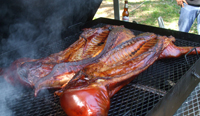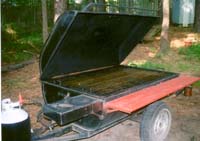|
Your First ‘Pig-Pickin’ - How to Cook a Pig
by: Donald Williamson
|
 So you’ve planned the special event, set the date, invited your family and friends,
decided on the food, the weather forecast looks great, but now you’re stuck
wondering …how am I going to cook the pig? I’ve never done that before! So you’ve planned the special event, set the date, invited your family and friends,
decided on the food, the weather forecast looks great, but now you’re stuck
wondering …how am I going to cook the pig? I’ve never done that before!
Cooking a pig, pork shoulders, or boston butt (no, it's not the actual butt) is not as hard as you think and a great social event that everyone will
remember for years to come. You just need the proper equipment, preparation and
time. Even if you’ve never cooked a pig or seen one being cooked, you will have
mastered the basics by the end of this article.
There are many ways that you can cook a pig – wood vs. gas vs. charcoal – and
even the cooking style (Eastern BBQ where you cook the entire pig served with a
vinegar sauce vs. Western BBQ where you cook shoulders served with a tomato
based sauce, but I don’t have the time or energy to debate this one now).
Let's Begin - How to Cook the PigWhile there are many variations in cooking a pig, it basically comes down to this:
- Thoroughly season the meat side of the pig with kosher salt
- Fire up the pig cooker to 250 degrees
- Place the pig on the grill, skin side down, and cook at 250 degrees for about 3 hours
- Increase the heat to 275
- Cook for another ~5 hours until the internal temp reaches at least 190 degrees
- Optional – mop with a vinegar-based sauce after 6 hours
- Enjoy!
Of course, this is the simplified version and there are several things you must
take into account but is still basically comes down to the above. So let’s get
started!
How Much Pork Should I Buy
A general rule of thumb I use is to take number of guests and times that by 1.15. So if you were feeding 75 people, you would need to order a dressed pig (pig completely cleaned and head removed) that weighs about 85 lbs (75 people x 1.15 = 86.25lb pork). This should give you about 37 lbs of cooked pork, or roughly 8 oz pork (half pound) per person.
Serving size: 8 oz pork/person
|
| Number of Guests |
Pork to Buy, lbs (dressed) |
| 100 |
115 lbs |
| 75 |
85 lbs |
| 50 |
55 lbs |
| 25 |
30 lbs |
| 10 |
12 lbs |
Of course you need to take into account how many kids will be there and the
number of sides dishes and other food you will have.
I would generally recommend that you have food leftover instead of not having
enough to feed your guests (and it freezes and reheasts very well).
Also of note is the size of the pig. I do not recommend ordering a pig under 70
pounds or over 125 pounds. The smaller pigs, to me, are too lean and pigs over
125 pounds start getting very tough and grainy (not to mention the difficulty
of working with them).
If you need less than a 70-pound pork, I would recommend switching to pork
shoulders instead. The cooking process is the same as below, just not quite as
long. If you need a pig over 125 pounds, consider getting a pig and a couple of shoulders. The “ideal’ dressed
pig weight for me is around 80-90 pounds
That all being said, if you have 5 people coming over and still want to cook a whole pig, go for it!
Ordering the PigIf you happen to live in the Raleigh, NC area, I always get my pig from Nahunta at
the downtown State Farmer’s Market. Other options are contacting your local
butcher or supermarket. Be sure to call them at least two weeks in advance to
be sure they will have your pig ready.
No matter where you order it, if you have a choice be sure the head is removed (the weight recommendations above are based on head removed. If leaving, add 10+ pounds – weight of head - to the ordering weight) . I also highly recommend that you
have them split the pig lengthways into two halves as it makes it much easier
to work with.
If you’re doing shoulders or boston butts, these can be found at most grocery and big box stores (COSTCO, SAMS, BJs)
The Pig Cooker
 If you don’t have the luxury of owning a pig cooker (or have a friend that you
can borrow one from), you will need to rent a cooker. Most rental places carry
these, at least in the south! If you don’t have the luxury of owning a pig cooker (or have a friend that you
can borrow one from), you will need to rent a cooker. Most rental places carry
these, at least in the south!
Gas vs. Wood/Charcoal
If you have a choice, rent a gas cooker. These are much easier to work
with and maintain a constant temperature. While cooking over wood or charcoal
does add extra flavor, the amount of time and work trying to maintain, and not
exceed, the required temperature is not worth the effort (for your first time
cooking anyways). You will get excellent results with the gas cooker and your
guests will not be able to tell the difference.
Final Preparations and Cooking Time
Your pig is ordered and you have the cooker. There are several other items you
will need:
- Meat Thermometer - preferably a digital one with a temperature probe that you
can leave in the pork. These are available at most food supply places.
- An accurate Grill Thermometer to measure the internal temperature of the
grill (available at BBQ shops or specialty food stores)
- Heat-resistant gloves (available at
hardware stores)
- Optional Basting Mop/Brush
- Chopping block
- Meat cleaver or large knife to chop or slice the meat
- Sauce for Basting
How Long Will Take To Cook The Pig?
Unfortunately when it comes to BBQ, the old saying goes to cook to the final temp, not time. That being said, you still need a game plan.
A general cooking-time rule you can start with is as follows:
| Weight of Pig |
Approximate Cooking Time (+/- one hour) |
| 75 lbs |
~7 hours |
| 100 lbs |
~8 hours |
| 125 lbs |
~9 hours |
You also need to factor in final rest and food preparation time. You will need at least
an additional 30 minutes to rest the pig and another 30
minutes to chop or pull the meat.
Cooking the Pig
The day has arrived. You’ve picked up your 85 lb pig and the cooker (and you
have two new tanks of gas!) and you want to eat at 6:00 pm. Now it’s time to
get down to business. Game time.
General Rules:
- While as tempting as it is for you and your cooking buddies, do not open the
lid or take ‘peeks’ during the cooking time more than is absolutely necessary.
According to tradition, every time you raise that lid, you are adding an additional 15 minutes of
cooking time!
- The ideal done temperature for the meat at its thickest point should be 190-195
degrees F. Take the temperature in both the ham and shoulder and be careful not
to touch the bone, as this will give a ‘false’ higher reading.
Time: 8:30 am
 Take the pig out of the cooler and very generously kosher salt or apply dry rub to the meat side of the
pig. Don’t skimp on the salt. Leave the pig out to start coming up to room
temperature. Take the pig out of the cooler and very generously kosher salt or apply dry rub to the meat side of the
pig. Don’t skimp on the salt. Leave the pig out to start coming up to room
temperature.
8:45 am
Fire up the cooker. Bring the temperature to 250 degrees.
9:00 am
Put the pig on the grill. You’ll probably need help from a friend. Place the pig
placed on the grill skin-side down (the ribs will be facing
up). Close the lid.
The temperature will come down on the cooker due to the coldness of the meat. Do
not raise the temperature. Lower is better at this point in the cooking stage
and I promise it will come back up.
9:30 am
Verify that you are no hotter than 250 degrees
10:00 am
Verify that you are no hotter than 250 degrees
11:00 am
Verify that you are no hotter than 250 degrees
12:00 pm (3 hours into cooking time)
You can now raise the temperature to 275 degrees. For the next couple hours, you will
start to smell it!
Pro Tip - once you hit around the ~165 degree mark, the meat will hit its stall point where the temp will not increase for a while (maybe even an hour). THIS IS COMPLETELY NORMAL and expected. Do not increase the grill temperature! Trust me, it will start raising again.
~3:00 pm: Once you see about an inch of liquid pooling in the belly cavity, take a long narrow knife and make a couple punctures down though the ribs and skin to let it drain out.
Optional – you can mop, or brush, some NC vinegar style sauce on the meat at this point.
5:00 pm (~8 hours into cooking time)
The pig should be done at this point and should have an internal temperature of at
least 190-195 degrees in both the hams and shoulders (be careful not to touch the bone when getting the temp). If not, continue cooking until the temp is 190.
Turn off the heat and let the meat rest for at least 30 minutes. Now take a drink of choice and pat yourself on the back for a job well
done!
Chopping/Pulling the Pork
Now that the pork is done and rested, it’s time to prepare the meat for serving. You can
either chop the pork or pull (shred) it.
To begin:
 Put your gloves on and gently lift out the ribs. Now pull out the
tenderloins (the ‘thick rope’ running down the backbones). Set these aside as
they are prized possessions that need to reserved for the proud chefs! Put your gloves on and gently lift out the ribs. Now pull out the
tenderloins (the ‘thick rope’ running down the backbones). Set these aside as
they are prized possessions that need to reserved for the proud chefs!
Now pull out the shoulders (front legs). Use both hands and twist it out.
Do the same on the hams (back legs) and place them in a large
pan or pot. Scrape out the ‘bacon’ or belly meat, as this is very
tender, and add it to the rest of the meat.
Now it’s just a matter of pulling off pieces, placing them on your cutting
board, and start chopping it with your cleaver or pulling into small pieces. Place these
in your serving tray and add a good dash of sauce. Repeat until you’re done.
 Now, you can sit back, relax and enjoy. You’ve earned it for a job well done! Now, you can sit back, relax and enjoy. You’ve earned it for a job well done!
Now that wasn’t so hard, was it?
Questions or Comments on this article?
Discuss in the forums
|
|



|
|
|